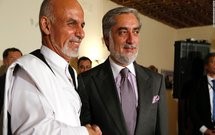 Will the new political arrangement (President and a Chief Executive Officer) in Afghanistan work, and more importantly, deliver? Though it looks simple in paper, given the recent history between the two contenders – Ashraf Ghani and Abdullah Abdullah – will the power-sharing deal help Afghanistan stabilise?
Will the new political arrangement (President and a Chief Executive Officer) in Afghanistan work, and more importantly, deliver? Though it looks simple in paper, given the recent history between the two contenders – Ashraf Ghani and Abdullah Abdullah – will the power-sharing deal help Afghanistan stabilise?
One Country, Two Executives
The understanding simply means that there would be two Executives for Afghanistan – the President (Ashraf Ghani) and a Chief Executive Officer (either Abdullah Abdullah, or someone nominated by him). It does solve the electoral dispute that had been raging between the two contenders and threatening to derail the political process. However, will the arrangement address the challenges facing Afghanistan?
The first set of challenges includes providing a coherent administration, better governance and addressing the looming economic crisis. One will have all the powers entrusted by the Constitution, while the other is yet to have a legal sanction – either via a Grand Jirga or the Parliament.
Also, the situation in the Afghan power structure is not as simple as two leaders trying to share power. It involves two sets of diverse groups attempting to share power and run a country, with the divide running across the ethnic lines. Neither side is monolithic; both leaders will have to address their constituencies, that not only involve respective communities – be it the Pashtuns, Tajiks and Hazaras – but also power leaders including provincial governors, warlords and even military officials within the Afghan National Army.
The Shifting American Focus towards Iraq
The agreement is primarily due to the US’ pressure. And that poses the second challenge for the new Afghan arrangement. How seriously committed will the US be, once the new Afghan structure is in place? Undoubtedly, the multiple visits by the US Secretary of State John Kerry and his constant dialogue with both parties have ensured that the electoral process has not been completely wasted. Abdullah was ready to leave the process and pursue a different political path. Thanks to Kerry, the two contestants could be brought together.
Will the US and Kerry have the same time and patience to continue their engagement with Afghanistan? The farewell speech is likely to leave a bad note in the Obama administration and the larger American nation. The US’ Ambassador to Afghanistan James B. Cunningham’s, remarks to outgoing Afghan President Hamid Karzai’s speech on 23 September will echo the larger American sentiment – ungrateful and ungracious. The new Afghan government have to work closely with the US government, and also address the prevailing sentiment about corruption and mis-governance, resulting in siphoning off the American tax payers’ money.
However, there are two positives for the US, as Karzai’s term ends. The US does not have to deal with him anymore and that should be a huge relief; the past year has been extremely bad and upsetting for the US. Second, the new president has already signed the Bilateral Security Agreement (BSA) with the US, followed by a similar one with the NATO.
Also, as it happened a decade ago, the US’s attention has been already diverted to Iraq. The airstrikes-only approach means the US needs to work harder to stitch a collation in the region and get regional boots on the ground. The return of the US to West Asia to destroy the Islamic State (IS) also means allocating considerable funds to train the Syrian opposition and augment the Iraqi security forces. Both – the diplomatic engagement in West Asia and raising local forces to fight the IS means less diplomatic time and financial resources for Afghanistan.
Advantage Taliban-Pakistan
The third major challenge would be the resurgence of the Taliban, and their supporters across the Durand Line. Despite multiple efforts, negotiations with the Taliban have not succeeded until today. Moving ahead, the reasons behind the failure would factor heavily in the new government.
There is no evidence at the ground level to prove that the Taliban infrastructure is destroyed. While the al Qaeda network in Pakistan has been substantially neutralised, the Taliban network across the Durand Line remains intact, and has in fact expanded further. The recent announcement that the Pakistani Taliban in Punjab would fight in Afghanistan underlines the Afghan Taliban’s strategic depth in the West. Mullah Omar has silently reversed the idea of “Strategic Depth” in the Af-Pak map; today the Afghan Taliban has enough safe havens, support structures and human resources deep inside Pakistan.
The new Afghan government with two executives would find it difficult to deal with such a complicated network that enjoys continuous support from across the Durand Line.
It’s the Economy, Stupid
The economic situation and the human development indicators have been transformed dramatically over the last decade. There are more schools, roads, transmission lines etc., than has ever been in the history of Afghanistan. The Afghan economy is evolving slowly but steadily, as are the country’s government structures and non-governmental institutions.
Herein lies the challenge. The above needs to be protected and expanded further, for which the new government would need strong financial support. Afghanistan is yet to become a regional economy and the much touted Heart of Asia. Though structures exist, there are no funds to support and finance the infrastructure and human resources that have been created during the last decade.
Securing what has been created so far itself will be a big challenge for the new president.
By Special Arrangement with Institute of Peace and Conflict Studies (http://www.ipcs.org)